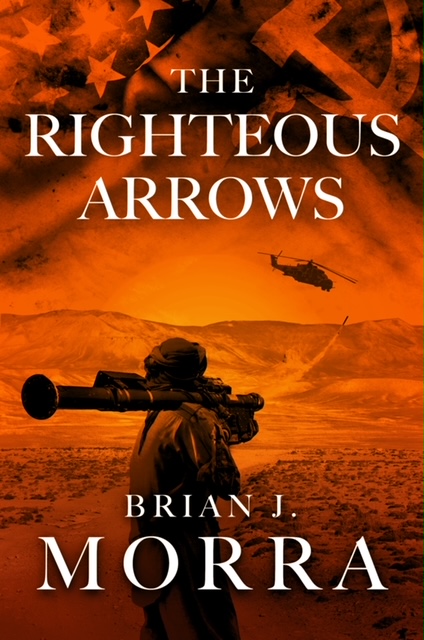Life After Able Archers: The Soviet Withdrawal from Afghanistan and the U.S. Learning Process
Brian Morra’s second book, The Righteous Arrows, continues the narrative of Russian and American operatives (in the previous book involved in dampening down the threat of nuclear war associated with 1983 events) engaged in adversarial competition. Now the main characters continue their competition into the Soviet engagement in Afghanistan.
The American operatives are working at the behest of the American government in providing aid to the Afghan rebel forces against the Soviets. A major element of that aid is to provide Stinger missiles to aid the rebels in attriting the Soviet air advantage.
The Afghans refer to the stinger as launching “righteous arrows” against the Soviet occupier.
But what did the Americans learn from their engagement under the table aiding the rebels in their fight against the Soviets?
That is a key question which is embedded in the book and is a central one when considering Washington today.
How do real world experiences in global conflict play into the inside the Beltway debates about the future of American foreign policy?
If the Afghan experience involving defeating the Soviets in Afghanistan is any example, the answer is clearly not very much.
The experience of the American operatives in Afghanistan was one of tribal conflict where no one controlled Afghanistan.
The Soviet leadership decided to withdraw but the U.S. leadership simply discounted this possiblity.
Stingers provided a technological advantage to the rebels which made a difference.
The inside the Beltway focus was upon how that technology made the difference and really ignored the nature of the Afghan tribes and their fundamental agreement really on one thing — they did not want a foreign force in their country.
The focus on stinger technology meant that any more fundamental lesson to be learned about the nature of why foreign powers die in Afghanistan was ignored. The fundamental reality of Afghanistan as the “graveyard of empires” was simply ignored. And when the U.S. went in, history was pushed aside for “stability operations” which lasted until Biden’s disastrous “Blitzkrieg withdrawal.
Towards the end of the book, Morra provides a look at a key American operative going back to Langley for a de-brief and the description of this meeting is very telling about American thinking about its global interventions.
The senior CIA official whose desk was more important than reality commented upon hearing the briefing from Captain Kevin Cattani, a US Air Force Intelligence Officer, who had just returned from the on the ground realities.
The senior CIA official comments: “The fact is that we must prevent the Soviets from having long-term control of Afghanistan. We can’t permit them to use it as a base of operations to create mischief in Southwest Asia. Whether Baluchistan is part of their plan is open to question, but we cannot risk them driving south toward the Indian Ocean. Surely, you must see that.”
Cattani is amazed at such an insight. He thinks: “Wow. They just don’t understand what’s going on over there.”
And he responds: “Sir, no one ‘controls’ Afghanistan. Certainly, the Soviets don’t. They aren’t winning in Afghanistan. They’re just bleeding. The Spetsnaz troops I saw in Pakistan are tough and professional, but they are not an all-conquering horde. I’m convinced they want to go home, not invade Baluchistan.”
“So, what do you think we should do, Captain?” It’s Barb, the Agency’s top Soviet analyst. She is scowling at me.
“I would ask, ‘What’s our objective?’ If it’s merely to kill Russians, then we should continue our arms deliveries, although I want to make a qualification to that point—in a minute. And if our objective is to induce the Soviets to withdraw, then I’m sure additional arms deliveries will not facilitate that goal. And here’s my qualification to my earlier statement. I want to stress that there is real risk in flooding the border regions and eastern Afghanistan with weapons. We do not control the actions of the groups getting those weapons. God knows what they’ll do with those arms once the Soviets withdraw, but it’s unlikely to be good.”
And the response was to blow off such an insight.
Later in the book Cattani reflects on what is his impact or role in American policy. Does what he is doing make a difference given the nature of the Washington DC policy machinery?
His thoughts are indicated as follows: “I am at a crossroads. Am I a functionary, a missionary, or a princeling? I am no functionary. The missionaries are running the CIA war against the Soviets. As always, the missionaries have good intentions, but will the law of unintended consequences shatter their illusions and defeat us in the long run?”
The book provides important insight into the world in which the United States engages in competition with deadly adversaries but must navigate with effectiveness with an ability to deal with adversaries, allies and partners alike rather than acting without any real ability to understand what is the end game.
I wish it was just a novel: but reads too much like contemporary history.
As Morra told me in a discussion I had recently with him about the book: “I had to re-read the book recently for its final edits prior to publication. And. in doing so, I find it very unsettling.
“I wrote this book to highlight the major gulf between the perceptions of policymakers and senior intelligence officials and what is actually going on on the ground.”
I highly recommend reading this book to share the unsettling reality of the gap between life inside the Beltway in the strategic community and what is going on in the ground around the world.

